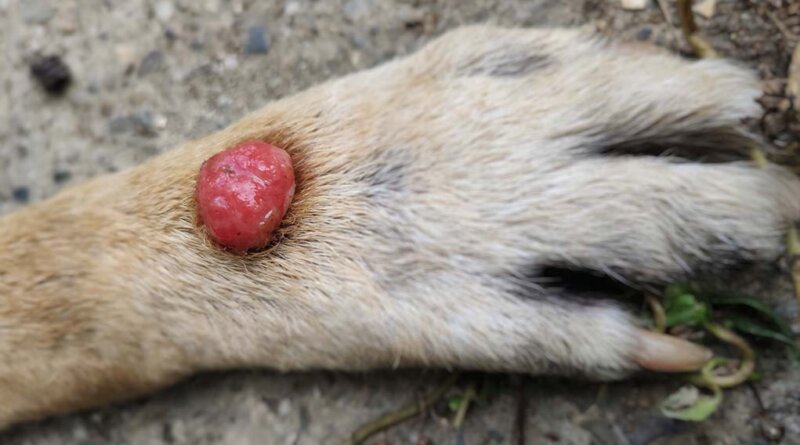Sebaceous Adenoma in Dogs: Diagnosis, Causes, Treatment,
When you come across a lump, bump or strange growth on your dog, it can be a scary experience. The first thought that comes to mind of a dog owner is often “cancer,” but fortunately, there’s generally no worries when it comes to sebaceous adenoma in dogs.
Skin conditions are common in dogs, and many lumps and bumps are completely harmless. That said, it is important to have your dog checked out by a veterinarian either way. In this article, we will talk about sebaceous adenoma in dogs, and provide tips for you to identify the problem and what action to take.
In this article we will discuss:
- What is a sebaceous adenoma?
- What causes a sebaceous adenoma in dogs?
- How do sebaceous adenomas affects dogs?
- How do vets tell if it is a sebaceous adenoma?
- How is a sebaceous cyst different from a sebaceous adenoma?
- What is the treatment for sebaceous adenomas in dogs?
What Is Sebaceous Adenoma in Dogs?
A sebaceous adenoma (or sebaceous gland adenoma) is one of the five types of sebaceous gland tumors on dogs; it’s a non-viral type of cutaneous wart (1). This means that the dog’s immune system doesn’t affect the mass.
Sebaceous adenomas are essentially benign tumors, which are non-cancerous and aren’t dangerous (2). It’s the most common type of tumor in dogs (3). Although they may look and sound scary, like warts, they cause no harm to your dog and can be left alone in most cases.
Occasionally, you will see small tufts of hair growing out of the dog’s sebaceous adenoma, although they are generally hairless protrusions resembling a cauliflower.
They are commonly found in the following areas of a dog’s body (4):
- Head
- Neck
- Back
- Eyelids
- Limbs
You are more likely to see sebaceous adenomas on senior dogs, with the average age being between 9 and 10.5 years, and with hindquarters, abdomen, and thorax being most commonly affected areas (5, 6). Dogs that are prone to them may develop more of these growths as they get older, too.
What Causes Sebaceous Adenomas in Dogs?
The sebaceous gland is an oil gland in the dog’s skin (7). It produces an oily substance called sebum, which helps to lubricate the skin. When it begins to overproduce oil, the gland itself increases in size, and can gets bigger.
It is easy, however, to distinguish a sebaceous adenoma from viral warts due to their oily nature. When squeezed, a clear or sometimes black colored oily substance extrudes from the skin pores.
How Do Sebaceous Adenomas Affect Dogs?
Sebaceous adenomas are not dangerous as they are benign and do not usually contain any cancer. They rarely need to be removed, and if left alone, they will often not bother your dog (8). However, there are a few ways that sebaceous adenomas can affect your dog.
Due to the fact that they secrete oil, scabs can sometimes form (9). The area can also become itchy, and if it is bothering your dog, then the dog can exacerbate the situation by scratching and causing secondary scabbing.
Sometimes, the sebaceous adenoma is in a tricky location on your dog’s body, causing a problem by either growing too big or being irritated when the dog lies down, eats or, in some cases, blinks – all depending on where the mass is situated on your dog’s body.
Removal of sebaceous adenomas is usually only considered in order to improve a dog’s quality of life, if they are chewing and licking the area constantly, or other problems have developed (10).
How Are Sebaceous Adenomas Diagnosed?
The diagnosis of a sebaceous adenoma on a dog will often depend on the history and examination of the mass (11).
When you take your dog to be checked by a veterinarian, you can expect to be asked some of the following questions:
- How long have you noticed the mass being there?
- How many masses have you found?
- Have you noticed any changes in appearance?
- How fast does it seem to be growing?
- Has your dog had any recent injuries or injections?
- Have you noticed any other changes in your pet’s behavior?
Your vet will also undertake a physical examination to determine whether or not the mass appears to be attached to the underlying skin or if it is ulcerated, and whether there is a presence of oil or secretion (12). They will check to see if the dog is in any kind of pain or discomfort, or whether the mass feels hot.
If your veterinarian is not certain that it is a sebaceous adenoma just by looking at it, or if they are not experienced with these growths and prefer to have a second opinion, then they may do a fine needle aspiration (13). If you are not sure about a veterinarian’s diagnosis, then you can request for them to have this done.
The fine needle aspiration procedure involves using a very tiny needle to remove cells from the growth. The cells are then sent to a pathologist for an evaluation, and a definite diagnosis can be arrived at.
Sebaceous Cyst vs. Sebaceous Adenoma
Sebaceous cysts in dogs are less common (14). They are thought to develop from an obstruction of the follicles, which leads to an abnormal accumulation of sebum.
A sebaceous cyst is essentially a small sac containing accumulation of sebum. Like sebaceous adenomas, these cysts are also benign, non-painful growths, although they can sometimes be tender to touch.
The difference between the two is that one is a cyst and one is a tumor. Cysts are sacs of tissue filled with another substance, like air or fluid. Tumors, on the other hand, are solid masses of tissue.
Treatment for Sebaceous Adenomas in Dogs
No treatment is required when the diagnosis is that it’s a sebaceous adenoma (15). There are occasions, however, when the area breaks open and bleeds, or has become infected due to the rubbing of a collar or leash, or your dog chewing at it.
Grooming procedures like brushing can also catch and cause a wound in the area. If the sebaceous adenoma is near the dog’s mouth, it may become damaged when the dog is eating, and if it is on the dog’s eyelid, this can lead to other problems, such as rubbing on the eye for example, causing corneal ulcerations (16).
When the circumstances require it, such as in the incidents described above, the sebaceous adenoma can be surgically removed along with a wedge of the underlying skin in order to ensure that none of it is left behind. The surgery is usually performed under general anesthesia.
Summary
A professional veterinarian should always check out any lump, bump, or growth on your pet’s body in order to rule out any serious conditions. If your dog does have a sebaceous adenoma, you may like to see this as good news, as generally speaking, these do not cause your dog any serious problem, as long as an eye is kept on the situation.
READ NEXT: Bumps on a Dog’s Back – 7 Things It Could Be and What To Do




